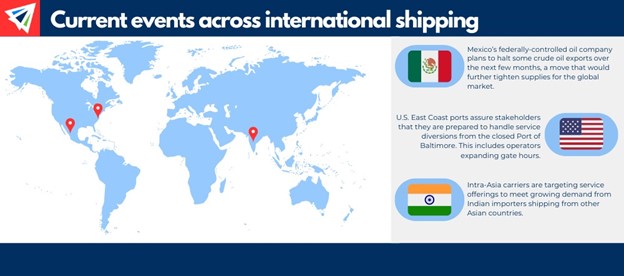
IMPORT: Asia to North America (TPEB)
Recent Developments:
- General rate increases (GRIs) were not implemented at the start of April.
Rates: The downward trend on rates continues to hold.
Space: Space is mostly open but has tightened in pockets.
Capacity: According to the Journal of Commerce ocean carriers are reducing their instances of blank sailings and increasing capacity in this market. The change in strategy suggests that continued longer voyages around Africa are requiring more vessel allocation than when the diversions began in December.
Equipment: Investments from independent equipment providers (IEPs) mirror expectations of an upswing in freight activity.
TIPS:
- Hold your logistics partners accountable for frequent updates regarding current market conditions and routing impacts.
- Be flexible and adaptive to alternative service options, especially as it relates to potential savings on cost or transit.
IMPORT: Europe to North America (TAWB)
Rates: Rates have decreased slightly.
Space: Space is open.
Capacity: This trade’s capacity glut has shown signs of improvement. There is lesser imbalance between capacity and demand.
TIPS:
- Book at least three weeks prior to the ready date.
- Familiarize yourself with the European Union’s ETS program and how its carbon taxing is impacting operating costs for ocean carriers.
EXPORT: North America to Asia
Rates: Rates have climbed after falling throughout March.
Capacity: Space remains open, particularly from West Coast ports.
Equipment: Export containers are being diverted to other East Coast ports of loading following the Port of Baltimore’s indefinite suspension to ship traffic.
TIPS:
- Insufficient communication with sailing schedules can lead to higher detention and demurrage fees as well as higher trucking and storage costs. Ensure your logistics partners are not keeping you and your cargo in the dark.